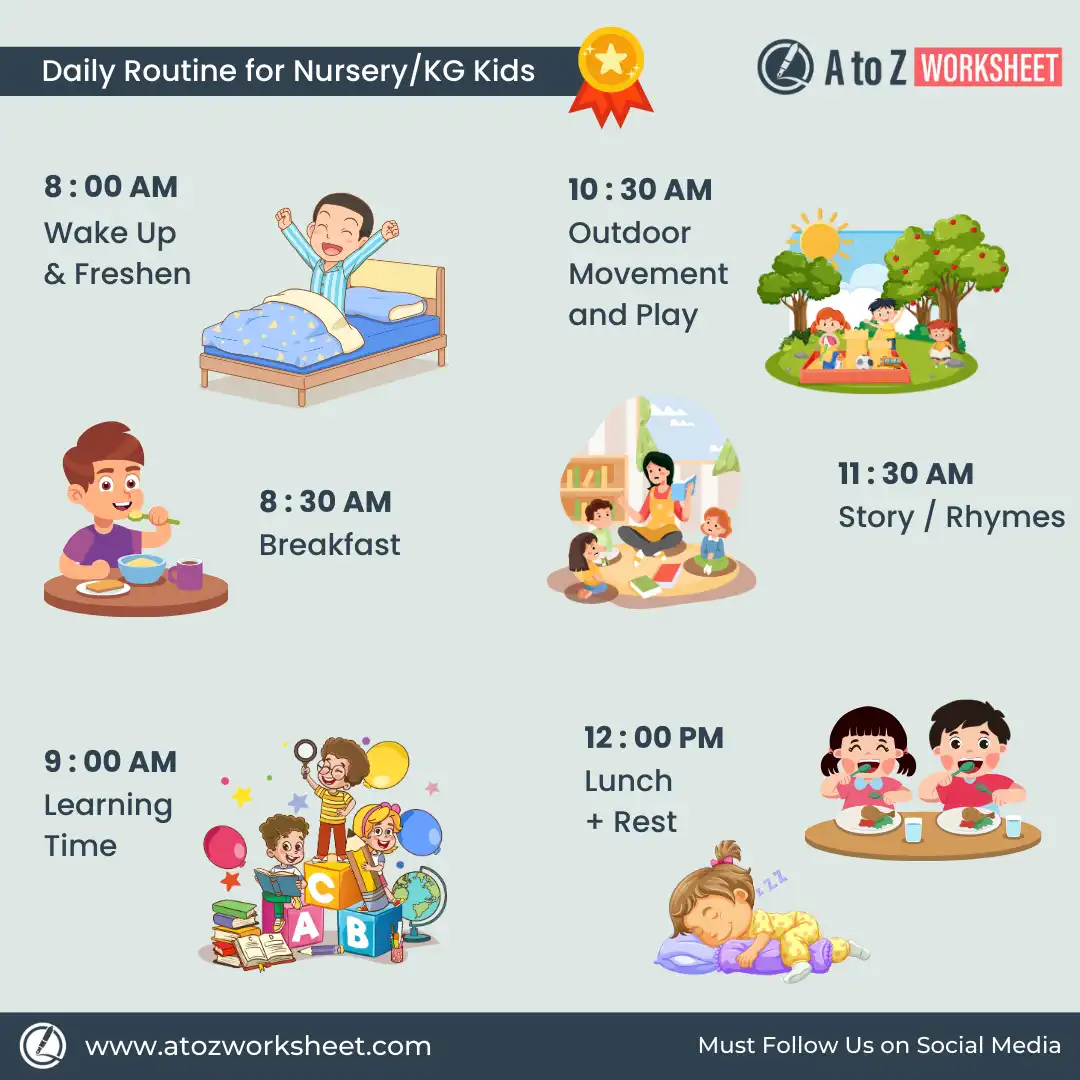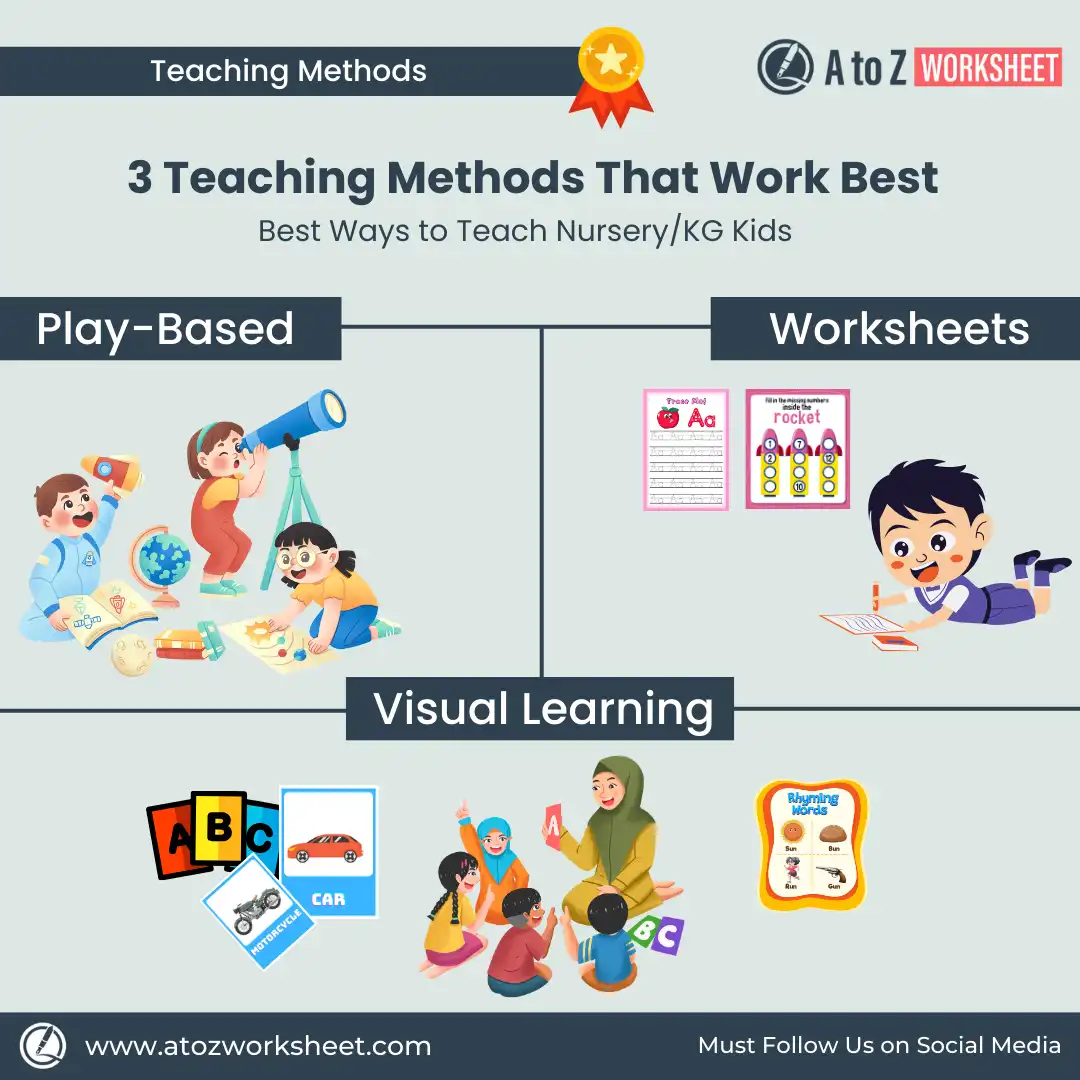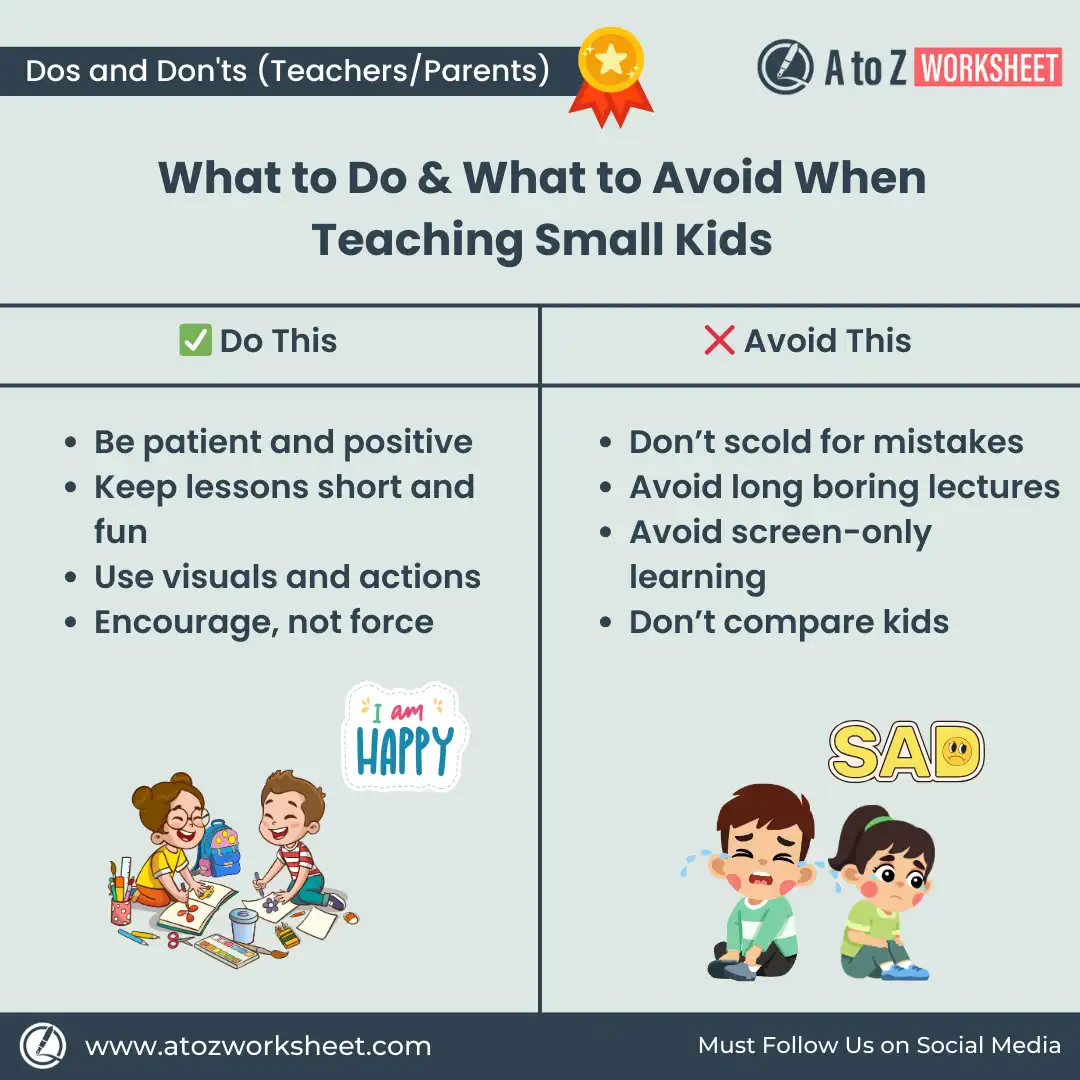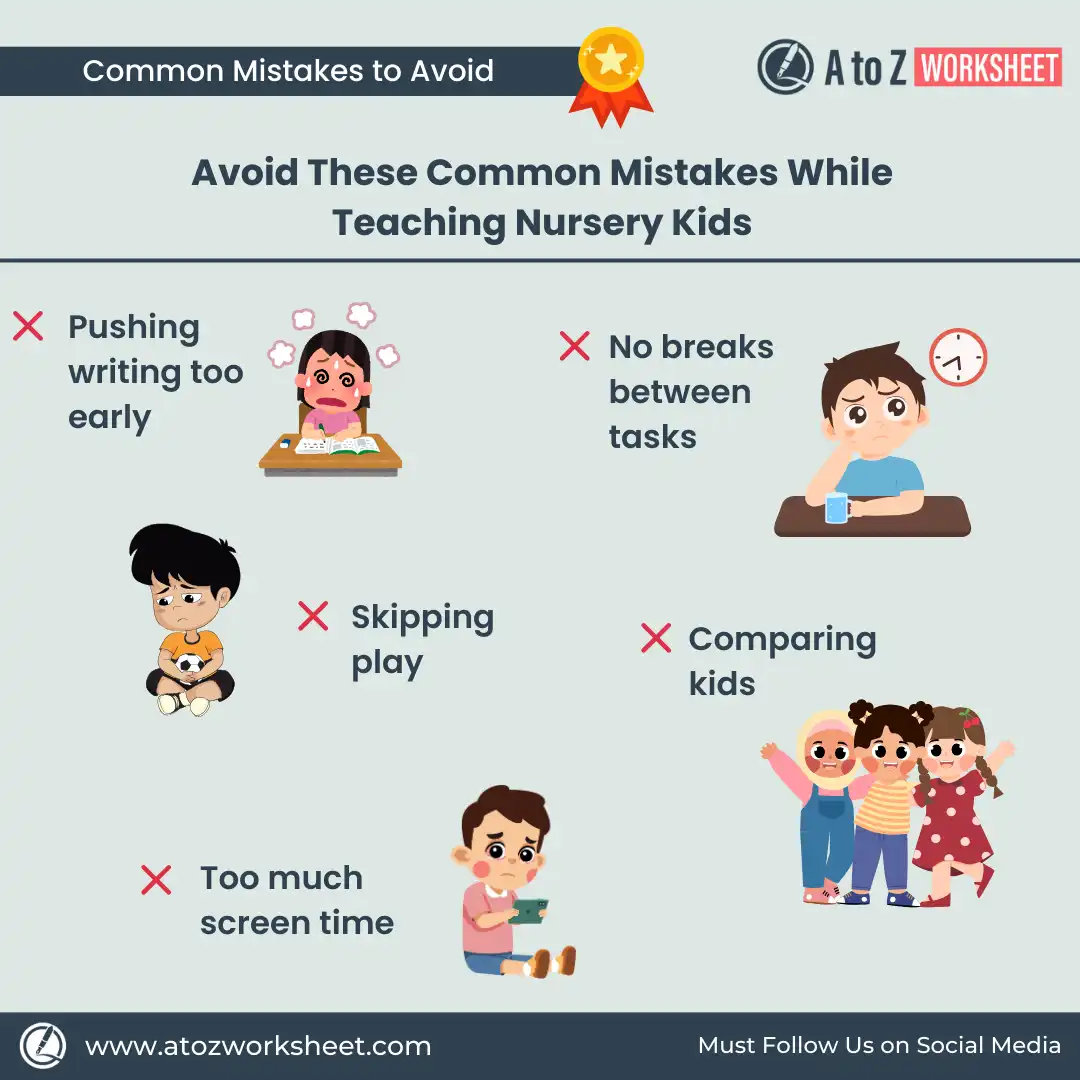Teaching nursery and kindergarten (KG) kids is one of the most rewarding and joyful experiences, which you might already know, but “How to Teach Nursery and KG Kids (A Step-by-Step Guide)” will surely help you and improve your teaching skills.
At the same time, it comes with its own challenges. Children between the ages of 3 and 5 are naturally curious, energetic, and eager to explore. However, it can be difficult to keep their attention, form daily habits, and make learning fun. This guide is specifically written for parents and teachers who want to make early education fun, effective, and stress-free.
In this article, we’ll explain simple, practical steps for teaching nursery and KG children. From creating daily routines to using worksheets and visual tools, you’ll find everything you need to support young learners at home or in the classroom.
Understanding the Mind of a 3 To 5 Year Old
Before we move on to the main content of the article and learn how to teach, it is important to understand how young children think and learn. Nursery and KG children are in a phase of rapid development. Their minds are like sponges, absorbing everything around them. But their attention span is short, and they learn best through play and repetition.
At this age, kids:
- Learn by seeing, touching, and doing
- Enjoy music, colors, and stories
- Need movement and play breaks often
- Respond better to encouragement than pressure
Trying to teach them like older students (with strict rules and long sessions) can backfire. Instead, focus on creating a calm, fun, and loving environment.
How to Teach Nursery and KG Kids
Start with a Daily Routine

Children thrive on routine. Set a simple schedule that includes play, snacks, study time, and rest. You don’t need to start with long hours. Just 15 to 30 minutes of learning time is enough in the beginning.
A good routine helps kids:
- Feel secure and confident
- Know what to expect next
- Develop discipline and habits early
Start with mornings – when kids are fresh and more alert. Keep the routine flexible but consistent.
Begin with the Basics
Start with simple and fun concepts like:
- Tracing Lines
- Alphabets (A to Z)
- Numbers (1 to 10)
- Colors and shapes
- Animals and fruits
It is important to use toys, flashcards, pictures and songs to introduce all these basic topics. While at home you can point out letters on cereal boxes, count fruit at breakfast time, or identify colors in their clothes. It is important to connect learning to real life, which helps them learn quickly.
Speak More, Write Less (Initially)
In the early weeks, focus on building vocabulary and comprehension. Let your child hear and say words often. Don’t rush into writing, as they still don’t have a grip on their pencil. It takes time to build hand control. First, develop interest and confidence with talking, singing and matching activities.
Whenever they don’t know how to write or hold a pencil properly, the first thing you should do is use line tracing worksheets. These types of worksheets have different types of lines that need to be traced. Using these, children develop a good grip on the pencil and gradually learn to write letters.
Teaching Methods That Actually Work

Play-Based Learning
Children love to play and it is their natural way of learning new things. Instead of asking them to read books, try activities like these:
- Sorting toys by color
- Matching socks or lids
- Singing alphabet songs with actions
- Dancing to number rhymes
This makes learning fun and keeps them interested. Since he has just started coming to school and learning, it is obvious that he is not fully prepared for these things yet and we have to make him ready.
Visual Learning
Experts say visuals help children remember better. Use posters, flashcards, charts or storybooks with pictures. Point to things and name them. Ask them to point or repeat after you. This is very important in early education.
For example, use a chart of animals and ask, “Where is the elephant?” Let them touch it. This improves recognition and memory. Posters, flashcards, charts, storybooks and worksheets are easily available.
Use of Printable Worksheets
Worksheets are a great tool if used correctly. They give kids a practical activity to apply what they have learned.
Start with simple ones:
- Matching pictures
- Tracing letters and numbers
- Coloring objects
- Finding differences
AtoZWorksheet.com, we offer free and premium worksheets specially designed for nursery and KG kids. These worksheets help reinforce learning and also make it fun. Try using 1-2 worksheets a day as part of a routine. With these, parents and teachers can track the progress of children, apart from this you can also use our Android app.
Best Practices for Parents & Teachers

Here are some tips that make a big difference:
- Be patient: Every child learns at their own pace. Avoid comparing.
- Celebrate small progress: Clap and cheer when they get something right.
- Break big tasks into small steps: Instead of teaching A to Z in one go, do 3–4 letters a week.
- Use gentle correction: Say, “Almost! Try again,” instead of “Wrong.”
- Keep sessions short and fun: 15–20 minutes is enough for most activities.
- Use movement: Let them jump, clap, or act out what they learn.
When kids feel safe, supported, and appreciated, they enjoy learning and show better results.
Common Mistakes to Avoid

Even with good intentions, some common mistakes can make learning harder for kids:
- Pushing too much: Don’t force writing or memorizing too early.
- Too much screen time: Digital tools help, but balance is key.
- Expecting perfection: Let kids make mistakes – that’s how they learn.
- Ignoring breaks: Kids need time to relax and play.
- Skipping play: Learning without fun feels like work – they’ll lose interest.
Avoiding these mistakes can make a huge difference in how your child responds to learning.
Free Tools and Resources
Here are some tools that can support your teaching journey:
- Printable worksheets: Visit our home page for free matching, tracing, coloring, and number worksheets.
- Story apps: Like “Kutuki”, “Google Read Along” or whichever app you like
- Educational songs: Find alphabet and number rhymes on YouTube (e.g., Cocomelon, ChuChu TV)
- DIY games: Sorting buttons, matching lids, drawing shapes
- Books: Colorful board books and picture storybooks
Mix these tools into your weekly routine. Keep switching up activities to hold their interest.
Topic List for Nursery & KG Students
Teaching nursery and kindergarten (KG) students is not just about teaching letters and numbers, it is about building a strong foundation for lifelong learning. At this early stage, children are developing motor skills, language comprehension, social behaviour and basic concepts that will support their future academic success.
That’s why a structured and balanced set of topics is important. The topics listed below have been carefully arranged to cover all the major learning domains: language, mathematics, environmental awareness, creativity and life skills – all specifically designed for children aged 3-5 years.
Language & Literacy (English or Mother Tongue)
Focus: Vocabulary, phonics, letter recognition, early reading
- Alphabet Recognition (A–Z, a–z)
- Letter Sounds (Phonics)
- Capital and Small Letter Matching
- Regional Language Basics (for bilingual skills)
- CVC Words (e.g., cat, bat, run)
- Simple Sight Words (like, the, and, is)
- Rhyming Words
- Picture Reading (Identify & Name)
- Beginning Letter Sounds
- Tracing Letters (A–Z)
- Simple Word Building
- Listening & Speaking Practice
- Story Time + Retelling
Mathematics Readiness
Focus: Number sense, counting, comparisons, patterns
- Number Recognition (1–20)
- Counting Objects
- Tracing Numbers (1–20)
- Missing Numbers
- Before, After, and Between Numbers
- Bigger and Smaller Numbers
- Number Matching
- Shapes Recognition (circle, square, triangle, etc.)
- Basic Patterns (ABAB, AABB)
- Same and Different
- More or Less
- Simple Addition & Subtraction (Visual Only)
Environmental Awareness & GK
Focus: Early world understanding
- Fruits and Vegetables
- Wild and Domestic Animals
- Body Parts
- Seasons
- Days of the Week
- Months of the Year
- Transport (Land, Water, Air)
- Birds and Insects
- Flowers
- Directions
- Stationary
- Clothes
- Food
- Time Concept (day/night, morning/evening)
- Our Community Helpers (doctor, teacher, etc.)
- Weather (sunny, rainy, cloudy)
- Sense Organs
- Living and Non-Living Things
- Clean and Dirty
Colors, Shapes & Visual Skills
Focus: Visual identification, cognitive thinking
- Primary & Secondary Colors
- Shape Matching
- Color the Object Worksheets
- Shadow Matching
- Spot the Difference
- Object Grouping
- Matching Pairs
- Sorting by Size / Shape / Color
- Picture-Object Association
- Memory Boosting Images (What’s Missing?)
Motor Skills Development (Fine & Gross)
Focus: Writing readiness, hand-eye coordination
- Scribbling Practice
- Line Tracing (Standing, Sleeping, Slanting)
- Shape Tracing
- Pattern Tracing (zig-zag, curves)
- Dot to Dot
- Join the Dots (Alphabet/Numbers)
- Coloring Activities
- Clay Molding / Paper Folding (for gross motor)
- Cutting Practice with Safety Scissors
- Finger Painting
Social & Emotional Skills
Focus: Self-awareness, interaction, expression
- My Family
- Good Habits (brushing, sharing, greeting)
- Manners (Please, Sorry, Thank You)
- Feelings and Emotions (happy, sad, angry)
- Festivals & Culture
- My School / My Home
- Friendship & Sharing Activities
- Safety Rules
- Gender Awareness (boy/girl basics)
- Role Play (shopkeeper, doctor, etc.)
Creative Expression & Play-Based Learning
Focus: Imagination, confidence, self-expression
- Free Drawing
- Coloring Within Shapes
- Introduction to Computers
- Singing Rhymes with Action
- Dance & Movement
- Story Creation with Pictures
- Role Play & Dress-Up
- Art & Craft with Paper
- Puppet Play
- Match-and-Play Games
- Pretend Play (kitchen, shopping, etc.)
Download the Complete Syllabus or Topic List for Nursery & KG Kids (PDF)
Tips for Parents & Teachers
- 🧒 Every child learns differently – some like drawing, others enjoy rhymes or play. Observe and follow their interests.
- 🕒 Keep study sessions short (15–30 mins) – long hours make small kids tired and lose interest.
- 👀 Use visuals and hands-on materials – flashcards, pictures, and worksheets help them understand better.
- 😄 Celebrate small achievements – a clap or smile can build a child’s confidence more than you think.
- ❌ Allow mistakes – learning isn’t about perfection, it’s about progress. Let them explore and try again.
- 🔁 Repeat important topics often – repetition helps build memory at this age.
- 🎶 Include songs, actions, and stories – fun-based learning keeps them engaged longer.
- 🧩 Switch activities every 10–15 minutes – change from writing to coloring, or from listening to singing.
- 🧘 Be calm and patient – they learn better when they feel safe and supported.
- 💡 Make learning part of daily life – count fruits, name colors in clothes, talk during walks.
Worksheets List For KG and Nursery
- Free 100+ Worksheet For Nursery (Fun and Educational Printables for Kids)
- Numbers Worksheet For Nursery, UKG and LKG
- Alphabet Worksheet For Nursery, UKG and LKG
- Master Writing With Simple Words Tracing Worksheet
- Rhyming Words Worksheet
- CVC Words Worksheets
- Animals Worksheet For Kids
- Drawing Worksheet For UKG, LKG, Nursery and Class 1
- Join The Dots and Dot to Dot Worksheet For Kids
FAQ
What age should I start teaching my child?
You can start around age 2.5 to 3 with basic concepts like colors, shapes, and rhymes. After this, you can teach things like alphabet and numbers, when they are ready.
How long should a study session be for nursery kids?
15 to 30 minutes is enough, with breaks in between. They are just starting to learn, so we have to make sure that they don’t find it boring. That’s why use fun activities, flash cards, and colorful worksheets so that they can learn while playing.
Can I teach my child at home without school?
Yes! With the right tools and routine, home learning can be just as effective for nursery-level kids. The advantage of this will be that they will start learning even before going to school and they will not find the school environment strange.
Which worksheets are best for KG children?
Start with matching, tracing, coloring, line tracing and simple writing worksheets. You can find many on our website AtoZWorksheet.com.
How do I keep my child interested in studying?
Use play-based activities, give praise, and keep switching between different learning styles (songs, games, worksheets).
Summary
Teaching nursery and KG kids doesn’t require fancy tools or pressure – just time, patience, and the right approach. How to Teach Nursery and KG Kids at Home or School (A Step-by-Step Guide) will definitely help you in this. Follow a routine, start simple, use visuals and worksheets, and most importantly, make it fun.
At this age, what matters most is that the child enjoys learning. When that happens, the results naturally follow. As a parent or teacher, your love, encouragement, and consistency are the real foundation of a child’s education. Start today with one small step -and enjoy the journey together.
I hope you like it and to get such worksheets for students on different topics, keep visiting our website atozworksheet.com. For instant updates, follow us on Instagram, Facebook, Pinterest, Telegram and subscribe to our YouTube channel.

